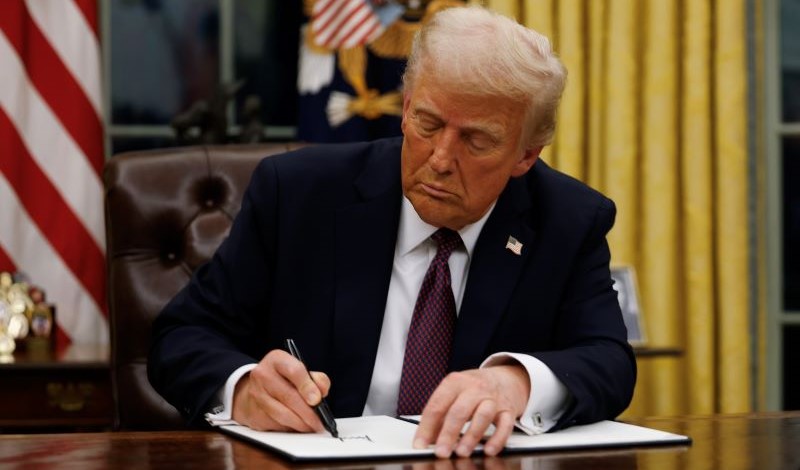
The presidential influence chronicled in Graham’s magisterial book now threatens technocratic decision-making.
Almost a decade ago, along with fellow scholars of regulatory governance Ashton Merck and Jonathan B. Wiener, I had the good fortune to conduct an extensive oral history with John D. Graham. The interviews focused on his experiences as the administrator of the Office of Information and Regulatory Affairs (OIRA) during the George W. Bush Administration. Graham’s recollections made clear that he had a steadfast commitment to public service, to the importance of rooting regulatory decision-making in careful analysis of risks, costs, and benefits, and to integration of regulatory governance with democratic principles and practices. He also articulated a set of bedrock principles for regulatory governance. These principles included a skepticism about strict command-and-control mandates; a strong preference for more flexible instruments, such as requirements of information disclosure, tradeable permits, and targeted taxes; and a conviction that the sitting President, as the only elected official chosen through a process that involves the entire country, should have wide leeway to set regulatory priorities concerning both rulemaking and enforcement by executive agencies.
Graham’s magisterial volume on the last 50 years of presidential approaches to regulatory tactics and strategy reflects this philosophy of governance. His history is grounded in scores of interviews with governmental officials, civil servants, and others who have played key roles in regulatory politics and decision-making, as well as voluminous government documents, extensive press coverage, and wide-ranging social science research on the U.S. regulatory state. Graham begins with an incisive overview of the modern policymaker’s regulatory toolbox, laying out the rationales for establishing regulation and providing a typology of regulatory strategy and tactics. He then offers detailed chapters that analyze major regulatory decisions during each presidential administration, from the Nixon Administration through most of the Biden Administration.
At times this review of regulatory proposals, enactments, and broader strategies risks overwhelming the reader. Graham provides scores of thumbnail sketches of regulatory policy dilemmas and choices, including both efforts to extend new regulatory rules and authority, and campaigns to remove longstanding regulations and deconstruct entire regulatory agencies. Each sketch is packed with details about the specific concerns leading to a proposed regulatory or deregulatory action, the wider political context, eventual decision-making, a balance sheet of positive and problematic social and economic policy impacts, and sometimes explicit calls for further research. Despite this encyclopedic approach, Graham’s penchant for crisp, clear prose keeps one moving through his examples. And anyone who wishes to trace developments in a specific regulatory domain, such as transportation, energy, finance, workplace safety, or drug safety, will find rich vignettes over the more than half-century he covers.
Throughout the book, Graham helpfully returns to a discrete set of themes. He pays close attention to the evolution of mechanisms intended to facilitate Presidents’ capacity to steer the regulatory ship. A focus on specifying regulatory costs amid the high inflation of the Nixon and Ford Administrations eventually gave way to a formal calculus of costs and benefits during the Carter, Reagan, and George H.W. Bush Administrations. The efforts of the 1970s Council on Wage and Price Stability evolved into the legislatively established Office of Information and Regulatory Affairs from the 1980s onward. OIRA, nestled within the Office of Management and Budget, steadily worked to refine analytical tools of benefit-cost analysis, to develop more holistic regulatory agendas within and across agencies, to add scientific expertise in risk assessment to a team once dominated by economists, and to extend its authority either to greenlight or forestall regulatory actions across the executive branch.
Graham emphasizes that under Democratic Presidents, there tended to be more emphasis on careful assessment of benefits as well as costs, alongside a willingness to consider other policy justifications for regulatory action. Indeed, President Joseph R. Biden explicitly required agencies to give weight to the distributional impacts of proposed regulatory policies. Graham also notes that some Republican administrations, such as the George W. Bush Administration, extended public access to information about decision-making within OIRA. For all the distinctive flavors of presidential engagement, the determination to entrench White House oversight of regulatory policymaking across the federal government remained bipartisan.
Graham further argues persuasively that every administration since 1968, regardless of political party, has simultaneously embraced a host of policies that both created new regulatory authority and sought to remove longstanding regulations and limit bureaucratic fetters on business or individuals. Under President Richard Nixon, for example, the federal government created the U.S. Environmental Protection Agency (EPA) and the Occupational Safety and Health Administration. Under President Jimmy Carter, deregulation of transportation and energy gathered pace. After the 9/11 terrorist attacks, the George W. Bush Administration oversaw a massive increase in security-related regulations, including the creation of the Transportation Safety Administration and the U.S. Department of Homeland Security. President Barack Obama prioritized exempting small businesses from unnecessary regulatory burdens and, arguably more than any other administration, using retrospective regulatory review as a way to identify rules that had outlived their usefulness. During his first term, President Donald J. Trump implemented draconian immigration regulations, particularly against individuals from predominately Muslim countries.
Presidents, Graham shows, have had convictions about regulatory governance born of their prior life experiences. President Carter demonstrated the frustrations of a former small business owner as a peanut farmer. President Ronald Reagan bore the marks of having served as a conservative spokesperson for decades. President Obama manifested deep faith in the competence of technocratic governance, reflecting his time at Harvard University and the University of Chicago. And President Trump showed a real estate developer’s disdain for the bureaucratic elements of regulatory process.
At the same time, Graham stresses that Presidents often revised their regulatory strategies in light of political realities, relying on appointments of agency heads, legislative initiatives, and OIRA scrutiny of planned agency actions. President Reagan moderated his approach to environmental regulation after initial blowback from appointees who had an antagonistic stance toward environmental constraints on businesses or individuals. Similarly, once the 1994 midterm elections signaled a strong conservative political shift, President Clinton embraced deregulation of maritime shipping, trucking, long-distance telephone markets, and, most importantly, key aspects of banking. And in the hopes of sidestepping negative political pressures, the Obama Administration slowed down several pending rules ahead of the 2012 election.
Although Graham puts his focus on presidential engagement with the regulatory state, he also traces the ebb and flow of congressional and judicial efforts to gain some measure of control over regulatory policymaking. At various junctures, he notes, members of Congress from both parties have advocated periodic review of previously adopted regulations, automatic sunset provisions, and mechanisms for Congress to veto regulations developed by agencies. The most far-reaching idea that became law was the 1994 Congressional Review Act, which allows Congress to pass a resolution disallowing a regulatory rule within 60 days of its issuance, subject to presidential veto. As Graham shows, however, the impact of this legislation has been fairly limited, with its biggest footprint occurring after shifts in presidential administrations.
During the late 20th century, Graham points out, the federal judiciary fluctuated between taking a “hard look” at how executive agencies interpreted the extent of regulatory authority provided by statute and extending considerable deference to agency interpretations when statutory language was ambiguous. In the early 21st century, by contrast, the U.S. Supreme Court has more consistently restricted the interpretive flexibility of agencies, especially in some pivotal environmental cases such as West Virginia v. EPA. The Court has also expanded the circumstances in which even independent regulatory agencies must demonstrate a factual basis for regulatory action and make credible determinations of benefits and costs. Across the full sweep of time covered in the book, federal judges have demonstrated a willingness to police the requirements of the Administrative Procedure Act (APA), such as appropriate opportunity for public notice and comment and agencies’ engagement with significant public concerns in developing regulatory rules. That scrutiny became especially significant during the first Trump Administration, since so many officials ignored APA provisions, curbing the Administration’s ability to reshape regulatory policy.
Arguably the most important theme for Graham involves the identification of regulatory strategies that actually achieved their goals at reasonable costs. He takes pains to chart the weaknesses of inflexible command-and-control regulation. The imposition of mandatory seatbelt interlocks in the 1970s, the detailed requirements to limit exposure to cotton dust in textile factories, and the initial refusal of the U.S. Food and Drug Administration to make it easier to test novel drugs in the face of the AIDS crisis—these and other such policies elicited strong contemporaneous critiques and significant popular opposition. Graham highlights the effectiveness, by contrast, of regulatory initiatives premised on flexible incentives, such as EPA’s decision in the 1970s to allow manufacturers to meet overall pollution targets across several factories—rather than requiring them to deal with plant-specific targets—and the reliance on tradeable permits to reduce acid rain. He also compliments the common choice of regulators over the last half-century to opt for strategies of information disclosure to facilitate better choices by individuals and firms.
For all the extraordinary coverage in the book, there are some notable absences. Graham has little to say about contexts in which Presidents opted for strategies of industry self-regulation, as occurred with nuclear safety after the Three Mile Island incident, or with oversight of financial stability in the run-up to the 2008 financial crisis. He largely skirts some big presidential decisions to hold off on regulating new industries, such as the Clinton Administration’s disinclination to crimp the style of internet commerce; the unwillingness of the George W. Bush Administration to regulate emerging financial instruments, such as collateralized debt obligations and credit default swaps that helped pave the way to the 2008 crisis; and the light touch that the George W. Bush, Obama, and first Trump Administration took with social media companies. Similarly, even though Graham takes note of a few environmental areas in which national policymakers chose to limit or prohibit state lawmakers and regulators from being able to diverge from national regulatory policy, he ignores the crucial impact of the increasing tendency to preempt state financial regulation. Graham also might have said more about the role of regulatory enforcement postures in areas such as antitrust, to which he gives little discussion until he turns to the Biden Administration.
In the conclusion, Graham appropriately takes note of major regulatory and deregulatory successes since 1968. The former include remarkable improvements in environmental conditions, declines in tobacco use, far safer highways, and more equitable access to health care; the latter include deregulation in transportation and energy, as well as relaxation of FDA rules to accelerate development of COVID-19 vaccines. He further inventories a host of emerging technologies that pose thorny regulatory questions, such as artificial intelligence, cryptocurrency, and autonomous vehicles, as well as “festering issues” such as climate change, delays in moving forward with public infrastructure projects, high levels of illegal immigration, and violence by firearms. As I pen this review early in the second Trump Administration, it is striking that this last group of areas that Graham identifies as needing attention does not include unprecedented economic inequality, rampant public skepticism of experts, heightened media concentration, and the increasingly unchecked spread of misinformation and disinformation.
History occasionally walks and sometimes trots or canters. At the moment, the pace of change feels more like a gallop. The institutions of American regulatory governance are very much in the current Administration’s crosshairs, through appointments to cabinet departments and regulatory agencies of individuals with a track record of hostility toward regulation, a concerted and dramatic effort to downsize the federal workforce and roll back regulations, and attempts essentially to close some regulatory agencies, including the Consumer Financial Protection Bureau.
Early portents from the federal courts suggest that the judiciary will continue to serve as a break on the Trump Administration’s ambitions. But with aggressive executive orders on regulation flying out of the White House, and Elon Musk’s Department of Government Efficiency barking orders via email and holding up payments of federal funds despite that agency’s tenuous legal foundation, concern for careful assessment of benefits and costs, and the mechanisms of notice-and-comment rulemaking, may soon seem quaint. For all of the insights that Graham provides in this important volume, the whirlwind currently crashing through the federal government should remind us that the past, including the history of regulatory governance, is always changing, as current circumstances raise new questions and illuminate new perspectives.
This essay is part of a series, titled “Presidential Legacies of Regulatory Reform.”




